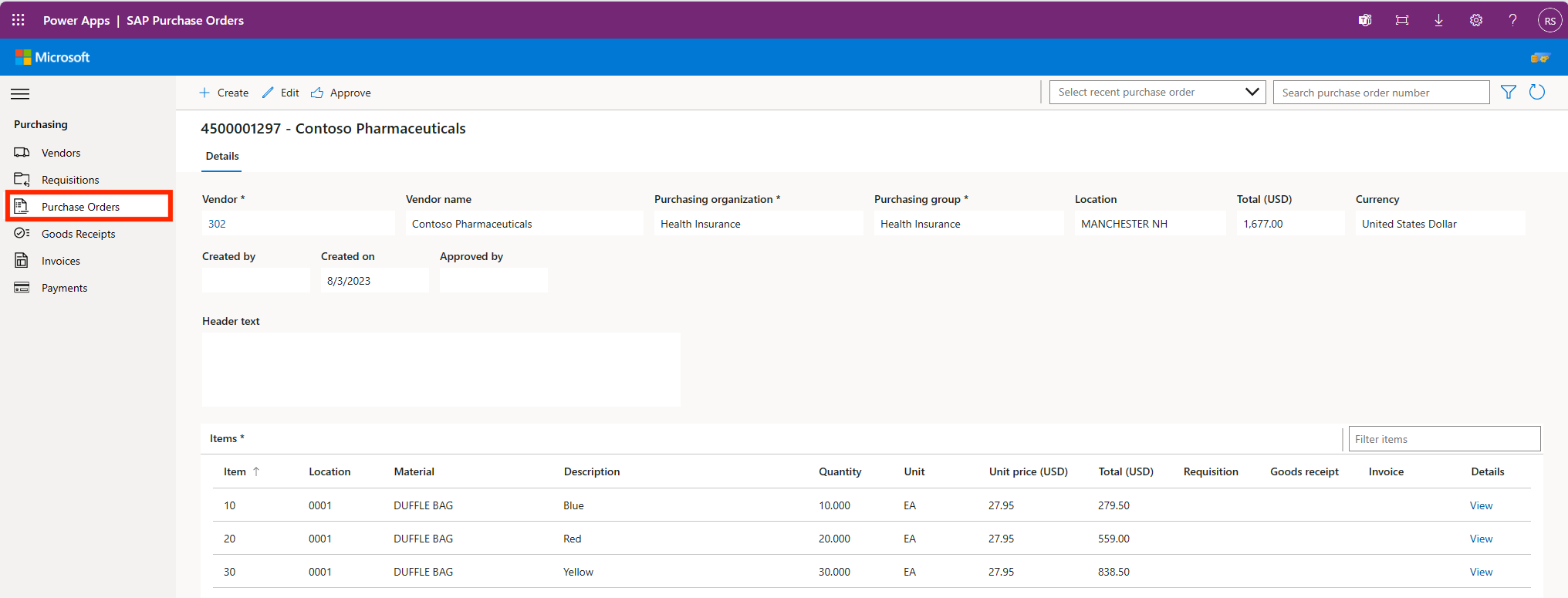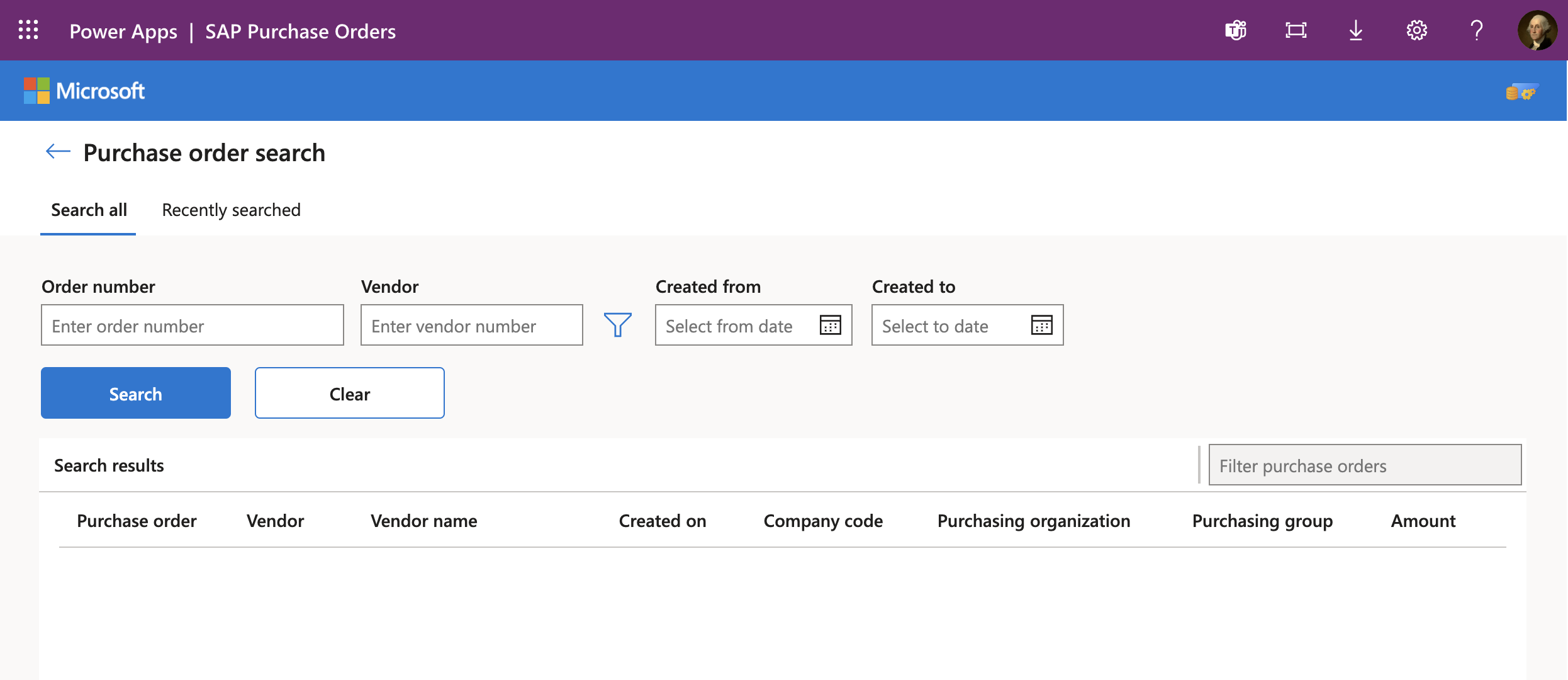Get started using the SAP Purchase Order Management app
The SAP Purchase Order Management app is part of the SAP Procurement solution for Microsoft Power Platform. It allows you to do several functions in SAP quicker and easier than using SAP GUI. You can search for, view, and change an existing purchase order (PO), or create a new PO.
Watch the demo
Watch the demo to see how you can manage your SAP PO data using the SAP Purchase Order Management app.
View a purchase order
You have three options for viewing a purchase order:
- Enter a known PO order number.
- Select a recent PO that you have interacted with.
- Search for a purchase order based on vendor and date range.

Enter a purchase order number
If you know the purchase order number, you can enter it in the Search purchase order number field.
Select a recent purchase order
You can select a recently viewed PO from the Select recent purchase order drop-down list. Choose a purchase order from the list to load onto your screen.
Search for a purchase order
If you haven't interacted with the purchase order, and you don't know the exact number, you can search for a PO.
Select the funnel to open the purchase order search screen. On the screen, you can search by entering information in either the Order number, Vendor, or Created from/Created to field or any combination of the fields.

Enter your selection criteria in the fields.
Select Search to display your results.
Select the PO you would like to see displayed on the PO overview screen.
Create a purchase order
You can create a new purchase order:
Select Create.
Enter a vendor number.
Select the arrow next to the vendor number to determine the vendor name.
Select the appropriate purchasing organization from the drop-down list.
Select the appropriate purchasing group from the drop-down list.
Select the appropriate location from the drop-down list.
Select the appropriate currency from the drop-down list.
Add a line item to a purchase order
Select + Add at the Items level.
View the new purchase order item details page.
Select your location (plant).
You can add the line item one of two ways:
- Enter a known material number.
- Search for a material. Select the filter symbol to open the material search page so you can search by material number, description, material type, or location (plant).
Example
Here is an example of a partial material number search within a location.
Select material number to search for a material.
Select a material from the drop-down list to populate that data into the new purchase order item detail screen.
Enter the quantity and the unit price. Performing the material search and selecting the material prepopulates the Unit field.
View the total automatically calculated based on the quantity multiplied by the unit price.
Select Done to add this line item to the purchase order.
Add, cancel, or save the purchase order
Select + Add for additional line items or select Cancel if you don't want to keep the purchase order. Selecting cancel removes everything.
Select Save when you're finished. When you select Save, the purchase order data will be saved to SAP and the SAP document number will appear in the upper left corner.
Additional functionality
When you load an existing purchase order, you have the ability to edit or approve it.
Edit a purchase order
If you select Edit, you're able to:
Change values
Add line items
Delete unwanted line items. To delete an unwanted line item, select the check box on the left side of the line item, and select Delete. You can also copy an existing line item by selecting it and selecting Copy.
If you want to edit a line, select the Edit link at the right side of the line item under Details.
Additional items functionality
You can sort column headings by ascending or descending order. To sort, select Column Heading. An arrow will appear to show you the sort order.
Note
The sort is done as a character string, so numbers may not be in numeric order.
You can also filter items in the Items list. The filter box can be found on the right side of the Items list.
Field mappings
Field mappings from purchase order screen to the function module.
BAPI_PO_CREATE1 Mapping
| Area | Display Name | Parameter | Field | Default |
|---|---|---|---|---|
| Header | Vendor | POHEADER | VENDOR | |
| Header | Vendor Name | POHEADER | Not Sent | |
| Header | Purchasing Organization | POHEADER | PURCH_ORG | |
| Header | Purchasing Group | POHEADER | PUR_GROUP | |
| Header | Currency | POHEADER | CURRENCY | |
| Line | Item | POITEM | PO_ITEM | |
| Line | Location | POITEM | PLANT | |
| Line | Material | POITEM | MATERIAL | |
| Line | Description | POITEM | SHORT_TEXT | |
| Line | Quantity | POITEM | QUANTITY | |
| Line | Unit | POITEM | PO_UNIT | |
| Condition | Item Number | POCOND | ITM_NUMBER | |
| Condition | Unit Price | POCOND | COND_VALUE | |
| Header (Default) | Document Type | POHEADER | DOC_TYPE | NB |
| Line (Default) | Update Indicator | POITEM | INFO_UPD | X |
| Condition (Default) | Condition Type | POCOND | COND_TYPE | PBXX |
| Condition (Default) | Condition Type | POCOND | CHANGE_ID | U |
BAPI_PO_CHANGE Mapping
| Area | Display Name | Parameter | Field | Default |
|---|---|---|---|---|
| Header | Order Number | PURCHASEORDER | ||
| Header | Vendor | POHEADER | VENDOR | |
| Header | Vendor Name | POHEADER | Not Sent | |
| Header | Purchasing Organization | POHEADER | PURCH_ORG | |
| Header | Purchasing Group | POHEADER | PUR_GROUP | |
| Header | Currency | POHEADER | CURRENCY | |
| Line | Item | POITEM | PO_ITEM | |
| Line | Location | POITEM | PLANT | |
| Line | Material | POITEM | MATERIAL | |
| Line | Description | POITEM | SHORT_TEXT | |
| Line | Quantity | POITEM | QUANTITY | |
| Line | Unit | POITEM | PO_UNIT | |
| Line | Crud Type | POITEM | DELETE_IND | |
| Schedule Line | Item | POSCHEDULE | PO_ITEM | |
| Schedule Line | Quantity | POSCHEDULE | QUANTITY | |
| Condition | Item Number | POCOND | ITM_NUMBER | |
| Condition | Unit Price | POCOND | COND_VALUE | |
| Header (Default) | Document Type | POHEADER | DOC_TYPE | NB |
| Line (Default) | Update Indicator | POITEM | INFO_UPD | X |
| Schedule Line (Default) | Schedule Line | POSCHEDULE | SCHED_LINE | NB |
| Condition (Default) | Condition Type | POCOND | COND_TYPE | PBXX |
| Condition (Default) | Condition Type | POCOND | CHANGE_ID | U |